无土栽培第四章
- 格式:ppt
- 大小:3.20 MB
- 文档页数:81

无土栽培原理与技术教材无土栽培是指通过一系列的生态种植技术,使用不含土壤的培养基,以水培或其他介质为载体,实现植物生长的一种方式。
由于其环保、高效、节约资源的特点,无土栽培在现代农业中越来越受到重视。
本教材将介绍无土栽培的原理与技术,以帮助读者全面了解并运用无土栽培技术。
第一章简介1.1 无土栽培概述1.2 无土栽培的历史和发展1.3 无土栽培的优势和应用领域第二章基础理论2.1 植物养分吸收与利用2.2 培养基的配制与调节2.3 植物水分管理2.4 光合作用与照明要求2.5 温度与湿度控制第三章系统组成3.1 灌溉系统3.2 养分供应系统3.3 光照系统3.4 控温控湿系统3.5 病虫害防治系统第四章无土栽培技术4.1 水培技术4.1.1 水培基本原理与操作步骤4.1.2 水培适用作物及其栽培要点4.2 基质培养技术4.2.1 基质培养基本原理与操作步骤4.2.2 基质培养适用作物及其栽培要点4.3 气溶胶培养技术4.3.1 气溶胶培养基本原理与操作步骤4.3.2 气溶胶培养适用作物及其栽培要点第五章无土栽培管理5.1 营养调控与养分供应5.2 灌溉管理5.3 光照管理5.4 控温控湿管理5.5 病虫害防治第六章无土栽培应用案例6.1 蔬菜类作物栽培实践6.2 水果类作物栽培实践6.3 花卉类作物栽培实践6.4 草坪与景观植物栽培实践第七章无土栽培未来发展趋势7.1 现阶段存在的问题与挑战7.2 可能的解决方案与创新技术7.3 无土栽培的前景与应用展望结语通过本教材的学习,读者将能够全面了解无土栽培的原理和技术,掌握无土栽培的基础理论,并能运用无土栽培技术进行实际生产。
无土栽培具备节水、无土壤病虫害、高效利用养分等优势,是未来农业发展的重要方向,也是实现可持续农业的重要手段。
希望本教材能够对读者在无土栽培领域的学习与研究提供帮助。

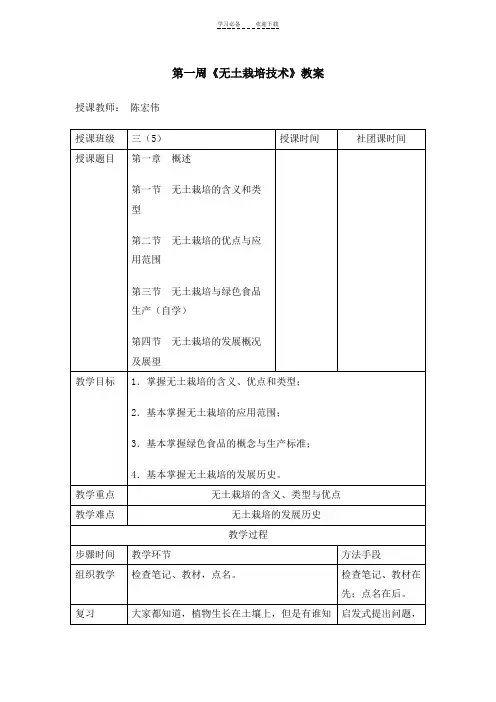
第一周《无土栽培技术》教案授课教师:陈宏伟
第二周《无土栽培技术》教案
第三周《无土栽培技术》教案
第四周《无土栽培技术》教案
第五周《无土栽培技术》教案授课教师:陈宏伟
第六周《无土栽培技术》教案授课教师:陈宏伟
第七周《无土栽培技术》教案授课教师:陈宏伟
第八周《无土栽培技术》教案授课教师:陈宏伟
第九周《无土栽培技术》教案授课教师:陈宏伟
第十周《无土栽培技术》教案授课教师:陈宏伟
第十一周《无土栽培技术》教案授课教师:陈宏伟
续上表:
第十二周《无土栽培技术》教案授课教师:陈宏伟
第十三周《无土栽培技术》教案授课教师:陈宏伟
第十四周《无土栽培技术》教案授课教师:陈宏伟
第十五周《无土栽培技术》教案授课教师:陈宏伟
第十六周《无土栽培技术》教案授课教师:陈宏伟
第十七周《无土栽培技术》教案授课教师:陈宏伟
第十八周《无土栽培技术》教案授课教师:陈宏伟
第十九周《无土栽培技术》教案授课教师:陈宏伟
第二十周《无土栽培技术》教案授课教师:。
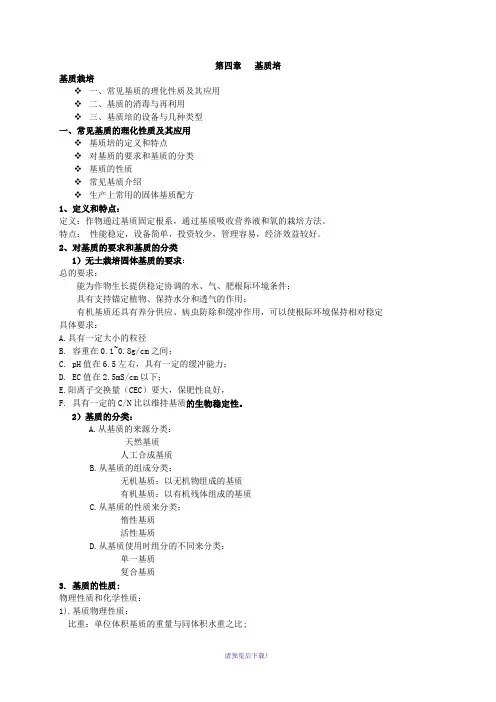
第四章基质培基质栽培❖一、常见基质的理化性质及其应用❖二、基质的消毒与再利用❖三、基质培的设备与几种类型一、常见基质的理化性质及其应用❖基质培的定义和特点❖对基质的要求和基质的分类❖基质的性质❖常见基质介绍❖生产上常用的固体基质配方1、定义和特点:定义:作物通过基质固定根系,通过基质吸收营养液和氧的栽培方法。
特点:性能稳定,设备简单,投资较少,管理容易,经济效益较好。
2、对基质的要求和基质的分类1)无土栽培固体基质的要求:总的要求:能为作物生长提供稳定协调的水、气、肥根际环境条件;具有支持锚定植物、保持水分和透气的作用;有机基质还具有养分供应、病虫防除和缓冲作用,可以使根际环境保持相对稳定具体要求:A.具有一定大小的粒径B. 容重在0.1~0.8g/cm之间;C. pH值在6.5左右,具有一定的缓冲能力;D. EC值在2.5mS/cm以下;E.阳离子交换量(CEC)要大,保肥性良好,F. 具有一定的C/N比以维持基质的生物稳定性。
2)基质的分类:A.从基质的来源分类:天然基质人工合成基质B.从基质的组成分类:无机基质:以无机物组成的基质有机基质:以有机残体组成的基质C.从基质的性质来分类:惰性基质活性基质D.从基质使用时组分的不同来分类:单一基质复合基质3. 基质的性质:物理性质和化学性质:1).基质物理性质:比重:单位体积基质的重量与同体积水重之比;容重:单位体积干基质的重量:0.2~0.8g/cm3总空隙度:基质中持水空隙与空气孔隙的总称,[ >54%,总空隙度=(1-容重/比重)*100%]气水比:大小空隙比=通气空隙/持水空隙;液态含量60%~70%,气态含量10%~20%粒径:基质颗粒直径的大小:0.5~5mm常见基质的物理性质:2)基质化学性质:稳定性:不会短期内分解淋溶出大量可溶性物质;PH:过大过小时可进行调节,亦可用复合基质调整;EC:基质溶于水中的所有阴阳离子浓度的总和测定方法:风干基质:蒸馏水=1:5混合振荡后静止,用EC计来测定CEC:每100毫克的基质中包含的全部交换性阳离子的毫摩尔数(常用钙镁离子含量来表示);缓冲能力:不同基质对酸碱的缓冲性差异很大;其他营养元素含量---有机基质里面含有植物生长必需要的营养元素等;4.常见基质的介绍:岩棉、砂、砾、珍珠岩、蛭石、锯木屑、泥炭、稻壳、棉籽壳、炉渣、椰糠、甘蔗渣。
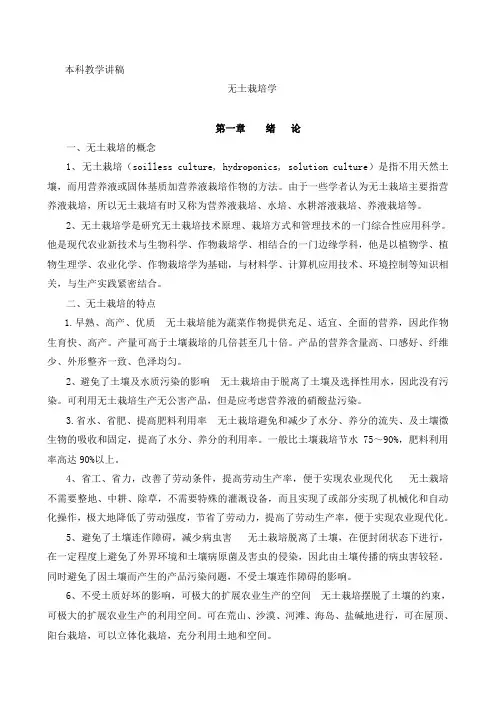
本科教学讲稿无土栽培学第一章绪论一、无土栽培的概念1、无土栽培(soilless culture, hydroponics, solution culture)是指不用天然土壤,而用营养液或固体基质加营养液栽培作物的方法。
由于一些学者认为无土栽培主要指营养液栽培,所以无土栽培有时又称为营养液栽培、水培、水耕溶液栽培、养液栽培等。
2、无土栽培学是研究无土栽培技术原理、栽培方式和管理技术的一门综合性应用科学。
他是现代农业新技术与生物科学、作物栽培学、相结合的一门边缘学科,他是以植物学、植物生理学、农业化学、作物栽培学为基础,与材料学、计算机应用技术、环境控制等知识相关,与生产实践紧密结合。
二、无土栽培的特点1.早熟、高产、优质无土栽培能为蔬菜作物提供充足、适宜、全面的营养,因此作物生育快、高产。
产量可高于土壤栽培的几倍甚至几十倍。
产品的营养含量高、口感好、纤维少、外形整齐一致、色泽均匀。
2、避免了土壤及水质污染的影响无土栽培由于脱离了土壤及选择性用水,因此没有污染。
可利用无土栽培生产无公害产品,但是应考虑营养液的硝酸盐污染。
3.省水、省肥、提高肥料利用率无土栽培避免和减少了水分、养分的流失、及土壤微生物的吸收和固定,提高了水分、养分的利用率。
一般比土壤栽培节水75~90%,肥料利用率高达90%以上。
4、省工、省力,改善了劳动条件,提高劳动生产率,便于实现农业现代化无土栽培不需要整地、中耕、除草,不需要特殊的灌溉设备,而且实现了或部分实现了机械化和自动化操作,极大地降低了劳动强度,节省了劳动力,提高了劳动生产率,便于实现农业现代化。
5、避免了土壤连作障碍,减少病虫害无土栽培脱离了土壤,在便封闭状态下进行,在一定程度上避免了外界环境和土壤病原菌及害虫的侵染,因此由土壤传播的病虫害较轻。
同时避免了因土壤而产生的产品污染问题,不受土壤连作障碍的影响。
6、不受土质好坏的影响,可极大的扩展农业生产的空间无土栽培摆脱了土壤的约束,可极大的扩展农业生产的利用空间。

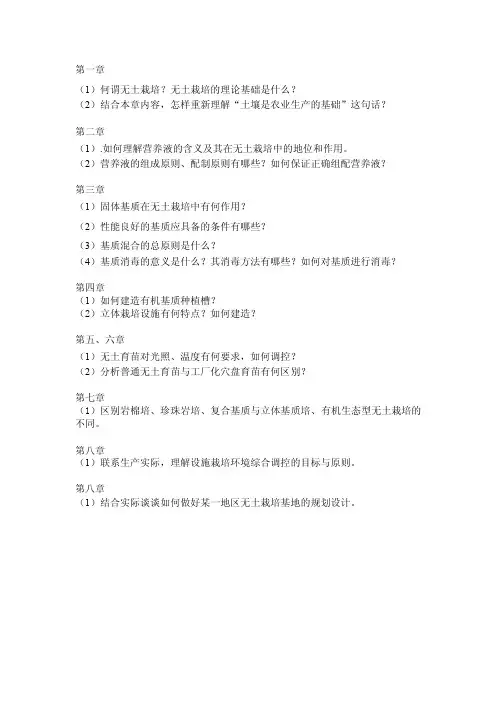
第一章
(1)何谓无土栽培?无土栽培的理论基础是什么?
(2)结合本章内容,怎样重新理解“土壤是农业生产的基础”这句话?
第二章
(1).如何理解营养液的含义及其在无土栽培中的地位和作用。
(2)营养液的组成原则、配制原则有哪些?如何保证正确组配营养液?
第三章
(1)固体基质在无土栽培中有何作用?
(2)性能良好的基质应具备的条件有哪些?
(3)基质混合的总原则是什么?
(4)基质消毒的意义是什么?其消毒方法有哪些?如何对基质进行消毒?
第四章
(1)如何建造有机基质种植槽?
(2)立体栽培设施有何特点?如何建造?
第五、六章
(1)无土育苗对光照、温度有何要求,如何调控?
(2)分析普通无土育苗与工厂化穴盘育苗有何区别?
第七章
(1)区别岩棉培、珍珠岩培、复合基质与立体基质培、有机生态型无土栽培的不同。
第八章
(1)联系生产实际,理解设施栽培环境综合调控的目标与原则。
第八章
(1)结合实际谈谈如何做好某一地区无土栽培基地的规划设计。
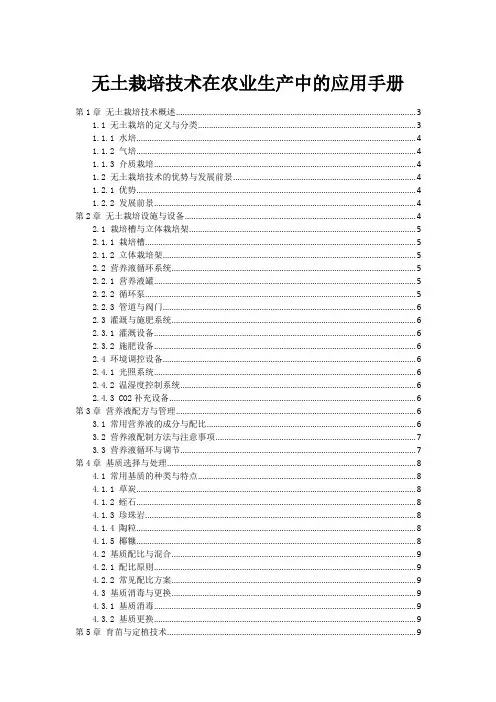
无土栽培技术在农业生产中的应用手册第1章无土栽培技术概述 (3)1.1 无土栽培的定义与分类 (3)1.1.1 水培 (4)1.1.2 气培 (4)1.1.3 介质栽培 (4)1.2 无土栽培技术的优势与发展前景 (4)1.2.1 优势 (4)1.2.2 发展前景 (4)第2章无土栽培设施与设备 (4)2.1 栽培槽与立体栽培架 (5)2.1.1 栽培槽 (5)2.1.2 立体栽培架 (5)2.2 营养液循环系统 (5)2.2.1 营养液罐 (5)2.2.2 循环泵 (5)2.2.3 管道与阀门 (6)2.3 灌溉与施肥系统 (6)2.3.1 灌溉设备 (6)2.3.2 施肥设备 (6)2.4 环境调控设备 (6)2.4.1 光照系统 (6)2.4.2 温湿度控制系统 (6)2.4.3 CO2补充设备 (6)第3章营养液配方与管理 (6)3.1 常用营养液的成分与配比 (6)3.2 营养液配制方法与注意事项 (7)3.3 营养液循环与调节 (7)第4章基质选择与处理 (8)4.1 常用基质的种类与特点 (8)4.1.1 草炭 (8)4.1.2 蛭石 (8)4.1.3 珍珠岩 (8)4.1.4 陶粒 (8)4.1.5 椰糠 (8)4.2 基质配比与混合 (9)4.2.1 配比原则 (9)4.2.2 常见配比方案 (9)4.3 基质消毒与更换 (9)4.3.1 基质消毒 (9)4.3.2 基质更换 (9)第5章育苗与定植技术 (9)5.1.1 育苗方法 (10)5.1.2 基质选择 (10)5.2 定植技术与移栽要点 (10)5.2.1 定植技术 (10)5.2.2 移栽要点 (10)5.3 水分与养分管理 (11)5.3.1 水分管理 (11)5.3.2 养分管理 (11)第6章常见蔬菜无土栽培技术 (11)6.1 叶菜类无土栽培技术 (11)6.1.1 菠菜无土栽培技术 (11)6.1.2 生菜无土栽培技术 (11)6.2 果菜类无土栽培技术 (11)6.2.1 番茄无土栽培技术 (11)6.2.2 茄子无土栽培技术 (12)6.3 根茎类无土栽培技术 (12)6.3.1 白萝卜无土栽培技术 (12)6.3.2 胡萝卜无土栽培技术 (12)第7章果树无土栽培技术 (12)7.1 苹果树无土栽培技术 (12)7.1.1 品种选择与种苗繁育 (12)7.1.2 栽培基质 (12)7.1.3 营养液管理 (12)7.1.4 栽培环境控制 (13)7.1.5 栽培管理 (13)7.2 柑橘树无土栽培技术 (13)7.2.1 品种选择与种苗繁育 (13)7.2.2 栽培基质 (13)7.2.3 营养液管理 (13)7.2.4 栽培环境控制 (13)7.2.5 栽培管理 (13)7.3 葡萄无土栽培技术 (13)7.3.1 品种选择与种苗繁育 (13)7.3.2 栽培基质 (13)7.3.3 营养液管理 (14)7.3.4 栽培环境控制 (14)7.3.5 栽培管理 (14)第8章花卉无土栽培技术 (14)8.1 室内观叶植物无土栽培技术 (14)8.1.1 品种选择 (14)8.1.2 基质选择与配比 (14)8.1.3 栽培管理 (14)8.2 切花类无土栽培技术 (15)8.2.2 基质选择与配比 (15)8.2.3 栽培管理 (15)8.3 盆花类无土栽培技术 (15)8.3.1 品种选择 (15)8.3.2 基质选择与配比 (15)8.3.3 栽培管理 (15)第9章病虫害防治与生理障碍调控 (16)9.1 常见病虫害防治方法 (16)9.1.1 生物防治 (16)9.1.2 化学防治 (16)9.1.3 物理防治 (16)9.1.4 综合防治 (16)9.2 生理障碍原因与解决措施 (16)9.2.1 常见生理障碍原因 (16)9.2.2 解决措施 (16)9.3 农药与肥料使用规范 (17)9.3.1 农药使用规范 (17)9.3.2 肥料使用规范 (17)第10章无土栽培在农业生产中的应用实例 (17)10.1 设施农业中的应用案例 (17)10.1.1 温室番茄无土栽培 (17)10.1.2 油菜无土栽培 (17)10.1.3 蔬菜立体无土栽培 (17)10.2 城市农业与家庭菜园 (18)10.2.1 屋顶花园无土栽培 (18)10.2.2 社区菜园无土栽培 (18)10.2.3 家庭菜园无土栽培 (18)10.3 节水农业与生态修复 (18)10.3.1 荒漠地区无土栽培 (18)10.3.2 盐碱地改良 (18)10.3.3 退化土地修复 (18)10.4 产业扶贫与乡村振兴中的应用前景 (18)10.4.1 产业扶贫项目 (18)10.4.2 乡村振兴战略 (18)10.4.3 农业产业结构调整 (19)第1章无土栽培技术概述1.1 无土栽培的定义与分类无土栽培,又称土壤无关栽培,是指在不使用自然土壤的条件下,利用营养液、人工基质或其他支撑介质,为植物提供必需营养元素,进行作物生长的一种现代农业技术。
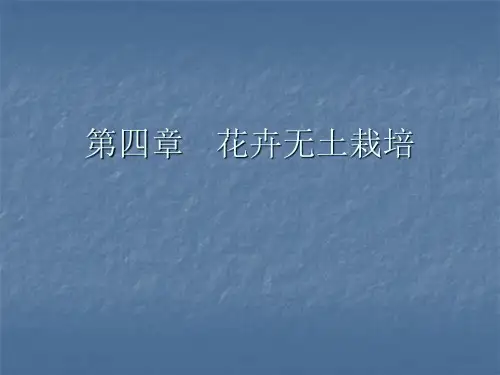
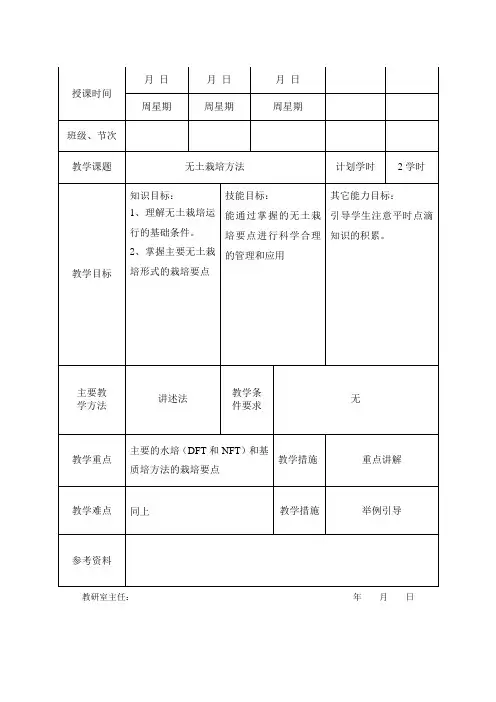
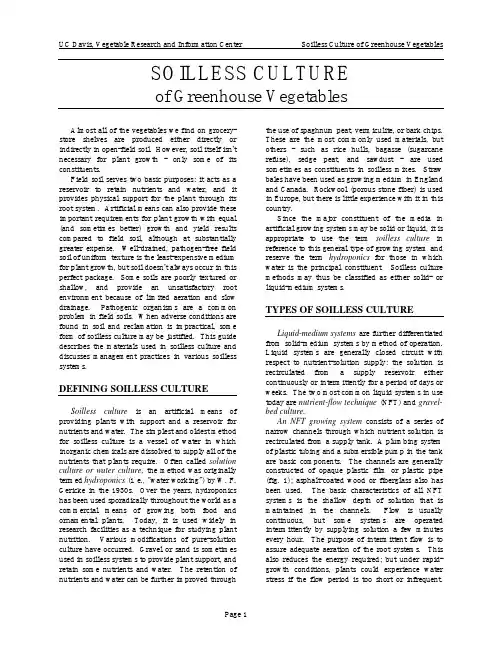
SOILLESS CULTURE of Greenhouse VegetablesAlmost all of the vegetables we find on grocery-store shelves are produced either directly or indirectly in open-field soil. However, soil itself isn't necessary for plant growth - only some of its constituents.Field soil serves two basic purposes: it acts as a reservoir to retain nutrients and water, and it provides physical support for the plant through its root system. Artificial means can also provide these important requirements for plant growth with equal (and sometimes better) growth and yield results compared to field soil, although at substantially greater expense. Well-drained, pathogen-free field soil of uniform texture is the least-expensive medium for plant growth, but soil doesn't always occur in this perfect package. Some soils are poorly textured or shallow, and provide an unsatisfactory root environment because of limited aeration and slow drainage. Pathogenic organisms are a common problem in field soils. When adverse conditions are found in soil and reclamation is impractical, some form of soilless culture may be justified. This guide describes the materials used in soilless culture and discusses management practices in various soilless systems.DEFINING SOILLESS CULTURE Soilless culture is an artificial means of providing plants with support and a reservoir for nutrients and water. The simplest and oldest method for soilless culture is a vessel of water in which inorganic chemicals are dissolved to supply all of the nutrients that plants require. Often called solution culture or water culture, the method was originally termed hydroponics (i. e., "water working") by W. F. Gericke in the 1930s. Over the years, hydroponics has been used sporadically throughout the world as a commercial means of growing both food and ornamental plants. Today, it is used widely in research facilities as a technique for studying plant nutrition. Various modifications of pure-solution culture have occurred. Gravel or sand is sometimes used in soilless systems to provide plant support, and retain some nutrients and water. The retention of nutrients and water can be further improved through the use of spaghnum peat, vermiculite, or bark chips. These are the most commonly used materials, but others - such as rice hulls, bagasse (sugarcane refuse), sedge peat, and sawdust - are used sometimes as constituents in soilless mixes. Straw bales have been used as growing medium in England and Canada. Rockwool (porous stone fiber) is used in Europe, but there is little experience with it in this country.Since the major constituent of the media in artificial growing systems may be solid or liquid, it is appropriate to use the term soilless culture in reference to this general type of growing system and reserve the term hydroponics for those in which water is the principal constituent. Soilless culture methods may thus be classified as either solid- or liquid-medium systems.TYPES OF SOILLESS CULTURE Liquid-medium systems are further differentiated from solid-medium systems by method of operation. Liquid systems are generally closed circuit with respect to nutrient-solution supply: the solution is recirculated from a supply reservoir either continuously or intermittently for a period of days or weeks. The two most common liquid systems in use today are nutrient-flow technique (NFT) and gravel-bed culture.An NFT growing system consists of a series of narrow channels through which nutrient solution is recirculated from a supply tank. A plumbing system of plastic tubing and a submersible pump in the tank are basic components. The channels are generally constructed of opaque plastic film or plastic pipe (fig. 1); asphalt-coated wood or fiberglass also has been used. The basic characteristics of all NFT systems is the shallow depth of solution that is maintained in the channels. Flow is usually continuous,but some systems are operated intermittently by supplying solution a few minutes every hour. The purpose of intermittent flow is to assure adequate aeration of the root systems. This also reduces the energy required; but under rapid-growth conditions, plants could experience water stress if the flow period is too short or infrequent.Therefore, intermittent-flow management seems better adapted to mild-temperature periods or to plantings during their early stages of development. Capillary matting is sometimes used in the bottom of NFT channels, principally to avoid the side-to-side meandering of the solution stream around young root systems, but it also acts as a reservoir by retaining nutrients and water during periods when flow ceases.NFT channels are frequently designed for a single row of plants with a channel width of 6 to 8 inches (15 to 20 cm). Wider channels of 12 to 15 inches (30 to 38 cm) have been used to accommodate two rows of plants, but meandering of the shallow solution stream becomes a problem with greater width. To minimize this problem, small dams can be created at intervals down the channel by placing thin wooden sticks crossways in the stream, or by the use of capillary matting. The channels will need to be sloped 4 to 6 inches per 100feet (10 to 15 cm per 30 in) to maintain gravity flow of the solution. Flow rate into the channels should be in the range of 1 to 2 quarts a minute (I to 2 liters a minute). Channel length should be limited to a maximum of 100 feet (30 in) in order to minimize increased solution temperature on bright days. The ideal solution temperature for tomatoes is 68o to 77o F (20o to 25o C). Temperatures of 59o or 86o F (15o or 3O o C) have been shown to decrease growth and yield of tomatoes. Black plastic-film channels will cause solution temperature to increase on sunny days. During cloudy weather, it may be necessary to heat the solution to the desirable temperature. Solution temperatures in black plastic channels can be decreased by shading or painting the surfaces white or silver. Cooper (1979) provides greater detail on NFT management.Gravel-bed culture utilizes a waterproof trough filled with pea gravel (or some other inert material of similar size), which is plumbed to a nutrient solution reservoir (fig. 2). Gravel particles retain very little water and nutrients, so the system must recirculate solution from the supply tank to the beds several times a day by means of a time clock and submersible pump. Some gravel systems are designed to be fed from the surface through perforated pipes, and drained at the base of the trough through a slitted drain line; others are both subirrigated and drained through a single pipe at the bottom of the bed. The advantage of the two-pipe system is that any root growth into the drain line will not interfere with the uniform distribution of nutrient solution to the bed. In either case, however, root growth will eventually clog the drain line and rotary cleaning equipment must be used to remove it.Gravel-bed troughs are generally 24 to 36 inches (60 to 90 cm) in width and 8 inches (20 cm) deep. Pea gravel must be thoroughly washed before use to remove particles of soil or other material that might clog the drain line. Care should be used in selecting a gravel supply that is free from pathogenic organisms. Treatment of the gravel by steam sterilization or an appropriate fungicide is a wise practice when condition of the material is uncertain.The nutrient-solution supply tank should be large enough to hold a volume of solution about twice that required to fill the beds; this provides a good marginof safety.The plumbing-system lines and submersible pumps should have the capacity to fill the beds in about 15 minutes, and allow complete drainage in 30 to 45 minutes.When managed properly, NFT and gravel-bed systems are capable of growing good crops, but there are some disadvantages that should be taken into consideration. The nutrient concentration of a recirculated nutrient solution is in a continuous state of change because plants are removing elements at different rates. Therefore, some means of monitoring and replenishing must be used to avoid deficiencies (and perhaps toxicities from excesses of some elements). This increases the cost of equipment and laboratory analysis. Recirculatedsystems are power dependent. If electrical energy is disrupted, there is little reservoir of water and nutrients to protect the plants from stress. Recirculation of the solution is an ideal means of spreading any pathogenic organism (such as water-mold fungi) that may be inadvertently introduced to the system. For these reasons, more management care, experience, and capital will be necessary for success with recirculated liquid-medium systems.Solid-medium soilless culture may employ any one of many types of suitable media in various types of containers. Basic requirements are a material of uniform texture that drains well yet retains some nutrients and water, a container in which the material is confined, and a means of supplying nutrient solution. A well-drained sandy loam could be used as a growing medium, but a supply of very uniform soil in the volume required may be difficult to find, and the weight of soil is much greater than other types of material. Sand has been used in soilless systems in which the entire floor of a greenhouse is filled a foot or more in depth, but it is rarely used in container systems because of its weight. Where sand is used, particle-size distribution is an important consideration in order to maintain a good balance between drainage (aeration) and nutrient and water retention. Particle sizes should be in the range of 0.1 to 1.0 mm with an average of 0.25 to 0.50 mm.Full-floor sand culture has been successful for vegetable culture in greenhouses and is considered a good means of providing plants with a uniform, well-drained rooting medium (fig. 3). Installation requires excavation of the greenhouse floor to the intended fill depth, and grading (about 4 inches per 100 feet [10 cm per 30 m]) for drainage. First, the graded area is covered with 10-mil plastic sheeting to prevent root penetration into the underlying soil. Then a system of drain tubes at the spacing of the plant rows is laid out on the plastic and connected to a common drain at the lower end of the house. Sand is then filled to the intended depth over the plastic sheeting and drain lines. Be careful to select sand according to its particle-size distribution, and its freedom from pathogens and constituents that might be toxic to the crop plants. Because of the permanent preparations for full-floor sand culture, it is recommended that sand intended for use in the system be given a growth test in containers before actually filling the greenhouse to determine if it meets the basic requirements.Sand-culture systems for tomatoes or cucumbers are typically irrigated and fertilized by trickle irrigation. The nutrient solution should be supplied at each irrigation because of the relatively low nutrient retention of sand. Irrigation frequency will vary with the crop, its growth stage, and the temperature, but will range from two to several times a day. Depending upon plant size and temperature, tomato and cucumber plants will require in the range of 1/2 to 4 quarts (1/2 to 4 liters) per plant a day. CONTAINER GROWINGSoilless culture in bags, pots, or troughs with a lightweight medium is the simplest, most economical, and easiest to manage of all soilless systems. The most common types of media used in containerized systems of soilless culture are peat-lite (Boodley and Sheldrake 1977), or a mixture of bark and wood chips. Container types range from long wooden troughs in which one or two rows of plants are grown, to polyethylene bags or rigid plastic pots containing one to three plants. Bag or pot systemsusing bark chips or peat-lite are in common use throughout the United States and offer some major advantages over other types of soilless culture: (1) the medium materials have excellent retention qualities for nutrients and water; (2) containers of medium are readily moved in or out of the greenhouse whenever necessary or desirable; (3) they are lightweight and easily handled; (4) the medium is useful for several successive crops; (5) the containers are significantly less expensive and less time-consuming to install- and (6) in comparison with recirculated-hydroponic systems, the nutrient-solution system is less complicated and less expensive to manage. From a plant-nutrition standpoint, the latter advantage is of significant importance. In a recirculated system, the solution is continuously changing in its concentration and its nutrient balance because of differential plant uptake.In the bag or pot system, the volume of medium per container varies from about 1/2 cubic foot ( 14 liters) in vertical poly bags or pots to 2 cubic feet (56 liters) in lay-flat bags. In the vertical-bag system, 4-mil black poly bags with pre-punched drain holes at the bottom are common. One, or sometimes two, tomato or cucumber plants are grown in each bag (fig. 4). Lay-flat bags accommodate two or three plants (fig. 5). In either case, the bags are aligned in rows with spacing appropriate to the type of crop being grown. It is good practice to place vertical bags or pots on a narrow sheet of plastic film to prevent root contact or penetration into the underlying soil. Lay-flat bags, which have drainage slits (or overflow ports) cut along the sides an inch (2. 54 cm) or so above the base, would also benefit from a protective plastic sheet beneath them. Greater detail on lay-flat bag culture is provided byBauerie (1984).Irrigation SystemsNutrient solution is delivered to the containers by supply lines of black polyethylene tubing to spaghetti tubing, spray sticks, or ring drippers in the containers. Application devices have different wetting patterns and are available in different flow rates. The choice of application system is important in order to provide proper wetting of the medium at each irrigation. Texture and porosity of the growing medium, and the surface area to be wetted are important considerations in making the choice. Spaghetti tubing provides a point-source wetting pattern, which might be appropriate for fine-textured types of media and allows water to be conducted laterally with ease. In lay-flat bags, single spaghetti tubes at individual plant holes will provide good wetting of peat-lite media. In a vertical bag containing porous medium, a spray stick with a 90-degree spray pattern will do a good job of irrigation if it is located to wet the majority of the surface. Ring drippers are also a good choice for vertical bags although somewhat more expensive. When choosing an application system for bag or container culture, remember that the objective of irrigation is to distribute nutrient solution uniformly so that all of the medium is wet. Since a root system cannot function in dry medium, dry medium is wasted medium.Growing MediaThe growing medium used in container culture must have good nutrient- and water-holding characteristics, and provide good aeration to the root system. Light weight is another important consideration so that filled containers can be easily handled. Growing media should be free of pathogenic organisms and substances that are toxic to plants. The principal materials that meet these requirements are peat moss, bark, shavings, sawdust, vermiculite, bagasse, and rice hulls. Table 1 provides a summary comparison of the characteristics of these materials. Some should not be used alone, but have one or more characteristics that make them valuable constituents when used in a mixture. Bagasse is low in porosity and high in water-holding capacity, which would lead to poor aeration and drainage if used alone. Because rice hulls have low water-holding capacity and high pore space, plants would be vulnerable to water stress when rice hulls are used alone. Both vermiculite and sawdust are poor choices as sole constituents because their high water-holding capacities can lead to saturation and poor aeration if over-irrigated. Vermiculite particles also tend to collapse with time, resulting in compaction and volume loss. Sawdust (except for cypress and redwood) and bagasse have high carbon: nitrogen ratios (C:N ratios), and require extra nitrogen fertilizer to avoid the competitive demand for nitrogen between microorganisms and the plants. Bagasse, rice hulls, sawdust, and vermiculite possess useful characteristics when used in mixes with other materials in the range of 20 percent to 50 percent of the total volume. Because of their high C:N ratios, bagasse and most sawdust material should be limited to no more than 20 percent of the total volume of a mix.Care should be used in the kind of wood material selected for soilless culture. Cedar, walnut, and eucalyptus may have components that are toxic to plants. Fresh redwood also affects the growth of some plants, but this effect becomes negligible with aging and leaching. The causes of toxicity from wood materials is not clearly understood, but probably varies with the type of plant being grown, and the type and age of wood being used. Wood materials are generally acidic and any toxicity from their use may be due to the effects of acidity on the availability of some nutrients to the plants. In redwood, the toxic component is transient because it decomposes or is leached away during composting. Materials such as pine sawdust decompose rapidly because of the high C:N ratio and, if supplemental nitrogen is not provided or is present in insufficient amount, the deficiency that develops may give the impression of toxicity. The barks of pine, fir, and redwood (and possibly others) can be safely used without growth-retarding effects, but cedar and walnut should be avoided. Sawdust and shavings of pine, fir, and redwood can make good, safe amendments when composted with nitrogen at 13 pounds per cubic yard (8 kg/m 3) for 2 to 3 months.Mixes should not be made merely to take advantage of availability or low cost, but should consider the basic factors of weight, nutrient retention, water-holding capacity, pore space, and C:N ratio. Mixtures of spaghnum peat and horticultural vermiculite (peat-lite) have all of the required characteristics and make an excellent growing medium. Proprietary peat-lite mixes are available, or growers can prepare their own supply from the basic components (Boodley and Sheldrake1977). Barks from pine, fir, cypress, and redwood have been used successfully as a growing medium for greenhouse cucumbers and tomatoes. Particle sizes of bark range generally from 1 to 10 mm in diameter; and the distribution of particle sizes in most mill-run material provides good aeration, and good water- and nutrient-holding characteristics. Abark medium can be used for several successive crops without a significant reduction in volume due to decomposition. A supply of bark with predominantly large particle sizes should be amended with a material such as sawdust, shavings,or bagasse in order to improve water-holdingcapacity.FERTILIZATIONIn field culture, the clay fraction of soils can be expected to supply adequate amounts of at least some of the nutrients required by plants, especially the minor elements.Fertilizer programs for soilless-culture systems must supply all nutrients required by the plants.Carbon, hydrogen, and oxygen are provided from water and carbon dioxide in the air. The grower will supply nitrogen, phosphorus, potassium, calcium,magnesium, sulfur, iron, boron, copper, zinc,manganese, molybdenum, and chlorine. Most medium materials contain small amounts of these elements; but they should not be considered in planning the fertilizer program because they are a small proportion of the requirement, or they may be in forms not readily available to plants.Liquid-medium systems - such as NFT and gravelbed culture - use complete nutrient solutions prepared from soluble inorganic salts containing various elements. Proprietary mixes of all required elements are available, which are simply dissolved inwater to prepare the nutrient solution. These mixes are available in various concentrations and ratios of elements. Nutrient solutions can also be prepared by the grower using readily available soluble salts.Many complete nutrient-solution formulas have been developed and used successfully. All contain the same elements and are generally prepared from the same compounds, although in somewhat different proportions. No one formula is necessarily the best for all plants, but all are capable of providing adequate nutrition. Special formulas are often recommended for a particular crop plant based upon research under the prevailing climatic and water quality conditions at a specific location. These formulas are soundly based for those conditions, but none should be construed as being the best universally under all conditions. They are good points of departure in developing a feeding program for the crop for which they are recommended, and may be well suited for use without alteration.Successful managers seek as much information as possible from reliable sources to develop a sound understanding of plant nutrition and inorganic chemistry before attempting to alter published formulas for their imagined or perceived needs.Improper alteration of formulas can lead to serious adverse effects due to excesses or deficiencies. It is recommended that growers either utilize prepared nutrient mixes obtained from reliable manufacturers or, if preparing their own, follow recommended formulas carefully. Competent assistance should be sought before making changes. Solid-medium systems - such as bark or peat-lite- can be provided with nutrients by three methods: (1) entirely from a complete nutrient solution; (2) from a combination of premixing some elements in the medium and supplying others by liquid feed; or (3) premixing all elements in the medium. The complete nutrient-solution method is commonly used in sand culture and for various mixed media or bark. Nutrient solution is applied up to several times a day to maintain the medium in a moist (but not saturated)condition. This system requires either a supply tank for the nutrient solution or a ratio feeder or fertilizer proportioner that prepares solution upon demand from stock nutrient concentrates. For small greenhouses, the frequent chore of replenishing the solution supply in a tank may be more attractive than investment in a fertilizer proportioner. When using the supply-tank method for a recirculated growing system, the tank should be large enough to hold a volume of solution about twice that required to fill the system. This provides a safe margin of nutrient supply.Nutrient-solution FormulasFormulas for several nutrient solutions are given in the Appendix, along with methods of preparation.While they differ in concentrations of the elements,all have been used successfully by commercial growing operations, principally for the production of tomatoes. Formula I has been widely used in research greenhouses as a general nutrient solution for a wide range of plants, and is a good formula choice where more specific information is not known for a particular crop. It is possible that adjustments in concentrations of some elements (particularly nitrogen, phosphorus, or potassium) may be beneficial to the yield or quality of a given crop.Until research is clear on this, however, it is best to adhere to the basic formula.The formulas in the Appendix list amounts of individual salts to be dissolved in 100 gallons (378liters) of water.This prepares the nutrient solution in the form to be supplied to plants from a storage tank. When a fertilizer proportioner is used, the amount of each salt must be adjusted to account for the dilution rate of the proportioner. By this method, liquid concentrates of the salts are prepared that will be diluted for the final nutrient solution as they are fed through the proportioner. For example (in formula 1), to calculate the amount of potassium nitrate to provide 50 gallons (190 liters) of concentrate to be used with a 200: 1 proportioner, divide 95 grams by 100 to obtain grams per gallon (or by 378 for grams per liter) in the final nutrient solution as shown, then multiply by 200 to obtain the amount in I gallon (or 1 liter) of concentrate, and finally multiply by 50 (or 190 liters) for the amount required for 50 gallons (190 liters) of concentrate. The amount of potassium nitrate required for 50 gallons (190 liters) of 200: 1concentrate is 20.9 pounds or 9550 grams. When preparing concentrates for proportioners, two separate concentrates are required to avoid precipitates. One contains only calcium nitrate and the iron compound; all other ingredients are in the other concentrate. The concentrates are kept in separate tanks and must be used in conjunction with a twin-head proportioner. When activated, the proportioner draws equal volumes from each tank and mixes them with an appropriate amount of water to provide the dilute nutrient solution.When using a proportioner, it is good practice to monitor its operation on a regular basis to be certain that solution of proper concentration of elements is being provided to the plants. This should be done in two ways. A water meter attached to the outlet side will record the volume of solution mixed for aparticular period of time. The depletion of concentrate volume in each tank over the same period of time and the volume of solution supplied should be in the same ratio as the dilution ratio of the proportioner. Another check on the system is to compare periodically the total salt concentration of a physical dilution of both concentrates with water.As an example, mix 200 ml of water with I ml (using a 1-mi pipette for measurement) of each concentrate. Salt concentration can be determined by an analytical laboratory or by a portable battery-operated instrument that measures electrical conductivity (fig. 7). During preparation of the concentrates, measurements of the individual salts should be made very carefully so that the final solution will contain amounts of individual elements as intended in the formula. Mistakes can be made,however, and for this reason it may be wise to sample the final solution from the proportioner and have a complete analysis made in a laboratory on a periodic basis.When premixing fertilizer materials with bark,or bark and sawdust, compounds that supply phosphorus, magnesium, calcium, sulfur, and all minor elements may be added to the growing medium prior to planting. A small amount of nitrogen may also be mixed with the medium I but most and sometimes all of this element is supplied in the irrigation water. Nitrogen is generally supplied in the nitrate form in the range of 100 to 200 ppm. 1The ammonium form of nitrogen, if included, should not exceed 10 percent of the total nitrogen supplied.Potassium also is supplied routinely with nitrogen in the irrigation water at about 200 ppm. A nitrogen/potassium liquid-feed solution providing 150 ppm nitrogen and 2 10 ppm potassium can be prepared by mixing 0.45 pound (208 gm) potassium nitrate and 0.40 pound (182 gm) calcium nitrate in 100 gallons (378 liters) of water. To premix the other elements in the medium per cubic yard (or cubic meter), phosphorus can be supplied as superphosphate (0-20-0) at 2 pounds (1 kg), calcium and magnesium from dolomitic lime at 10 pounds (4.5 kg), and minor elements from trace element mixes such as FTE 503 or Esmigran at 5 ounces (155 gm). Additional iron may be added in dilutedform at I ounce (28 gm) of 138 Fe.The method of premixing all fertilizer materials in the medium before planting may include the use of slow-release nitrogen materials such as Mag-amp,Osmocote, isobutylidene diurea (IBDU), or sulfur-coated urea (SCU). This method is not commonly used but, when compared to the liquid-feed method,it is reported to produce equal or better yields of tomatoes (Sheldrake, Dallwyn, and Sangster 1971).The premix method offers important advantages by eliminating the need to prepare nutrient solutions,and the purchase and maintenance of a fertilizer proportioner. The potential disadvantage of slow-release fertilizers that supply all of the nitrogen and potassium is that they may not be able to release the elements at the proper rate to satisfy the plants'needs. While slow-release fertilizers are widely used in the ornamental plant industry, their success rate and cost-effectiveness on vegetables in soilless culture have not been adequately established. Until more information becomes available, it is suggested that their use be limited to medium amendments in proven fertilizer programs.1ppm (parts per million) = mg per liter. Calculation example: to obtain 100 ppm N from potassium nitrate (14 percent N), 100 / 0. 14= 715 mg potassium nitrate/liter = 0. 715 gm/liter = 2.79 gm potassium nitrate/gallon (1 gallon = 3.785 liters).。
《“无土栽培”三部曲》谚语说:“万物土中生”,植物的生长都离不开土壤,可是当无土栽培出现的时候,“万物土中生”这句古老的谚语已经被改写。
有了这种栽培,你可以在寸草不生的茫茫沙漠等等一切您认为不容易栽种的地方进行植物的种植,使不能再生的耕地资源得到了扩展和补充,从而使农业生产有可能彻底摆脱自然条件的制约,完全按照人的愿望,向着自动化、机械化和工厂化的生产方式发展。
对于无土栽培来说,它的方式方法多种多样,目前最有代表性的是基质栽培、水培、气雾培三种,这也是无土栽培的三部曲,它们构成了先进栽培方式的主旋律。
基质栽培,就是采用土壤的替代物来进行种植,最大的优点就是避免土壤的病虫害,那么那些材料能作为基质使用呢?蛭石、珍珠岩、草炭、菇渣、这些都是我们常用到的基质;看,这些摘下来的老秧和叶子也不会像我们平常一样把它们作为垃圾丢掉,它们将被粉碎进行汁液的分离,分离出来的渣子与菇渣等进行干烘发酵完全以后呢,就可以成为上等的栽培基质。
虽然找到了土壤替代物,但是这种替代物能满足植物的生长吗?首先我们先来看看植物生长需要什么?它们需要微量元素、水分、氧气。
在基质栽培方式中,植物生长所需要营养主要是由精心配制的营养液提供,不同的植物有着不同的配方,它们按照一定比例配在水中,然后通过滴灌系统或细流灌溉的方法浇在基质中,这样而被作物的根系吸收,维持植物的整个生长期。
基质栽培中基质的品种不断随着农作物种植的需要在丰富,而栽培中所用的装置也没有停止过前进的脚步。
最初级的栽培方式,就是用一块塑料薄膜,把基质跟土壤隔开。
相对来说袋栽和槽栽的栽培方式有了很大改进,袋栽就是把植物种在一个个打了孔的塑料袋里,它由于是封闭型的,相对来说保水性好一些,水分不容易流失,但是也很容易导致植物根部无法呼吸而死亡。
而这种槽栽的基质栽培方式,它是一个开放系统,这样通透性比较好,根系发育比较好,但是同时由于是开放系统,如果营养液多呢,就会像这样一样白白的流失了。